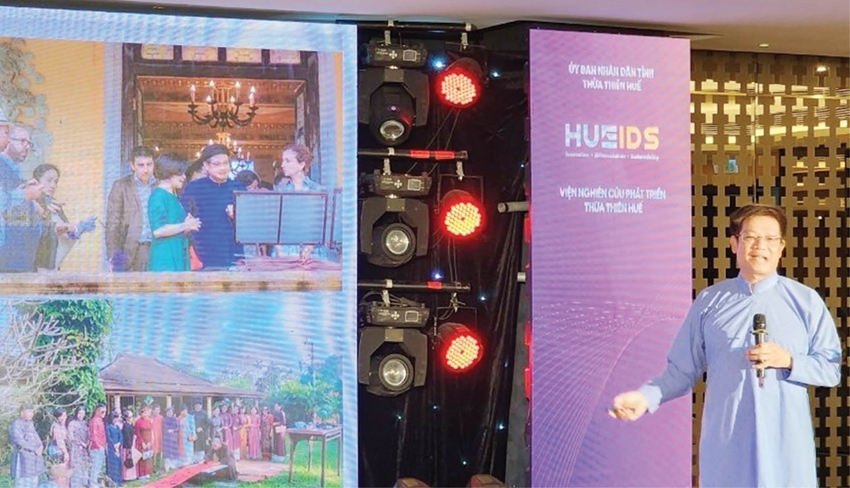 |
| Dr. Phan Thanh Hai shares his story of developing the brand name of Ao Dai at a conference |
Dr. Phan Thanh Hai, Director of the Department of Culture and Sports, made that comparison between the development of a national brand for Ao Dai and Hanbok in his journey to to revive and strongly develop the Ao Dai. Moreover, it is possible to make Ao Dai a typical product of the creative and cultural industry. Dr. Hai has just returned from a business trip to Korea to attend the Hanbok exhibition event at the invitation of the Korean Cultural Heritage Promotion Association. He was very surprised and impressed by how they worked methodically and professionally.
At the conference “UNESCO Creative Cities Network and the possibility of transforming cultural resources in Hue”, Dr. Hai recounted that the exhibition attracted more than 100 companies specializing in designing this type of clothing and related accessories. They brought a wide variety of products from traditional Hanbok to modern and traditional Hanbok styles, accessories such as hats, scarves, shoes, bags, handbags, brooches, hairpins, wig tails... These products were for both men and women, from children, youth, middle-aged to the elderly customers.
Through this event, Dr. Hai commented that Korean people see Hanbok as a pride. Therefore, they had a methodical approach to communicate their traditions and promote tourism. Although it is rarely used in daily life as Ao Dai Vietnam, Hanbok has still been a famous brand, becoming an impressive image in the international arena.
 |
| Ao Dai Vietnam in today's life |
More importantly, the Korean government clearly understands the value of the Hanbok brand and always actively supports the recovery of this type of clothing, while actively focus on Hanbok branding and promoting. They encourage and always accompany designers and artisans in the development of Hanbok. They also consider Hanbok as a specific cultural industrial product and a national brand. In addition, they always take full advantage of technological strengths to support the recovery and spread of Hanbok through the digital technology.
As for Mr. Hai, what “his ears heard” from Korean Hanbok was considered an extremely valuable lesson in making Ao Dai Vietnam become a typical product of the creative and cultural industry.
In the immediate future, Dr. Hai believed that it would be necessary to officially recognize and honor Ao Dai as a valuable traditional cultural heritage of the nation, and to include Ao Dai in the list of national intangible cultural heritage with a number of outstanding criteria. Regarding this, he said that in early 2022, Thua Thien Hue province submitted documents to the Department of Cultural Heritage to register Ao Dai with two criteria: the profession of tailoring the five-panel Ao Dai and the custom of wearing Ao Dai of Hue people.
“In the long term, it is entirely possible to create a dossier of Ao Dai with a number of typical and outstanding criteria to request UNESCO to enroll it in the Representative List of Intangible Heritage. But first, we need to officially honor Ao Dai within our country. It should be added that the issue of honoring Ao Dai has been of interest to some researchers and the community for a long time,” suggested Dr. Hai.
Sharing more about “Hue – the Capital of Ao Dai Vietnam”, an on-going project with many specific goals and is considered “a typical cultural model” and very commendable, Dr. Hai still believed that it would be very essential to have a national policy for the revival and development of this type of costume.
“It is necessary to consider Ao Dai as a precious heritage, a typical national brand as the way the Koreans do with their Hanbok. From then, the Government will assign relevant ministries and branches to research and promulgate policies on supporting the development of Ao Dai, artisans, materials, as well as promoting, organizing exhibitions, design competitions to enhance the development of ao dai...,” hoped Dr. Hai.
